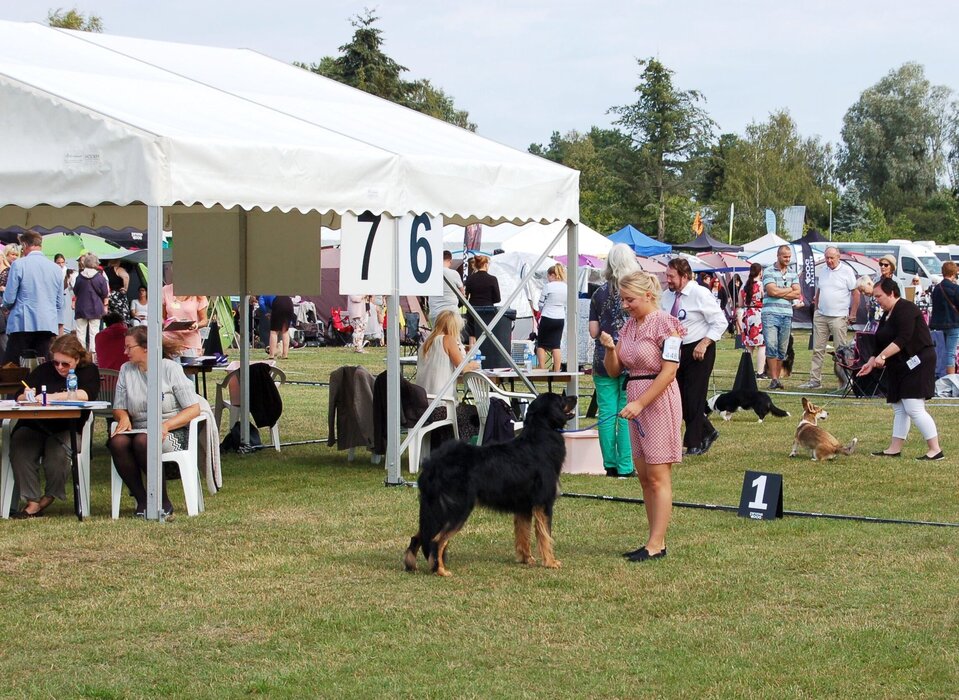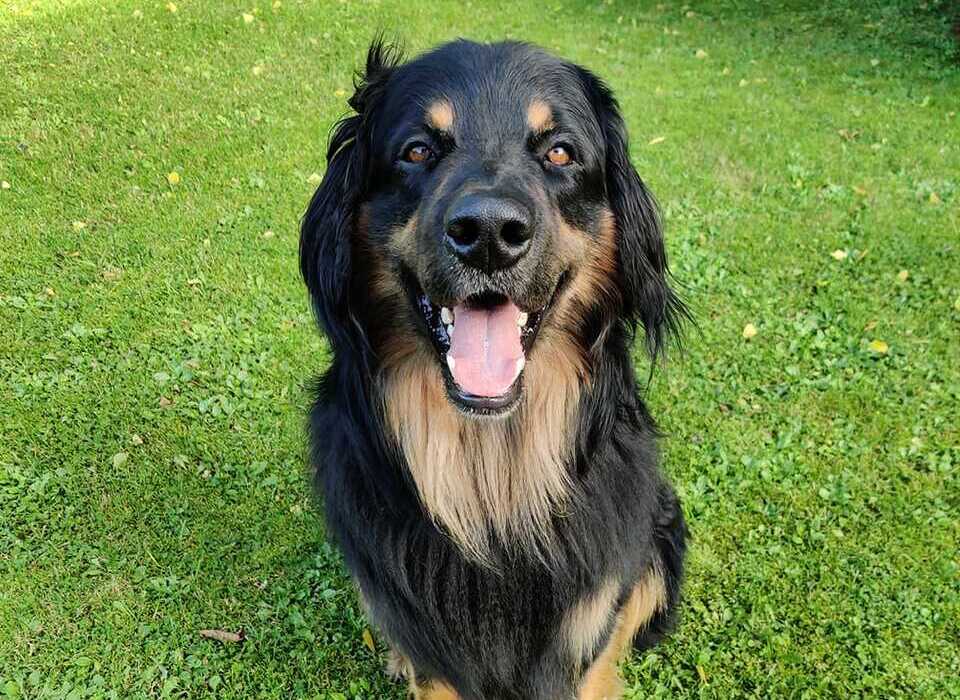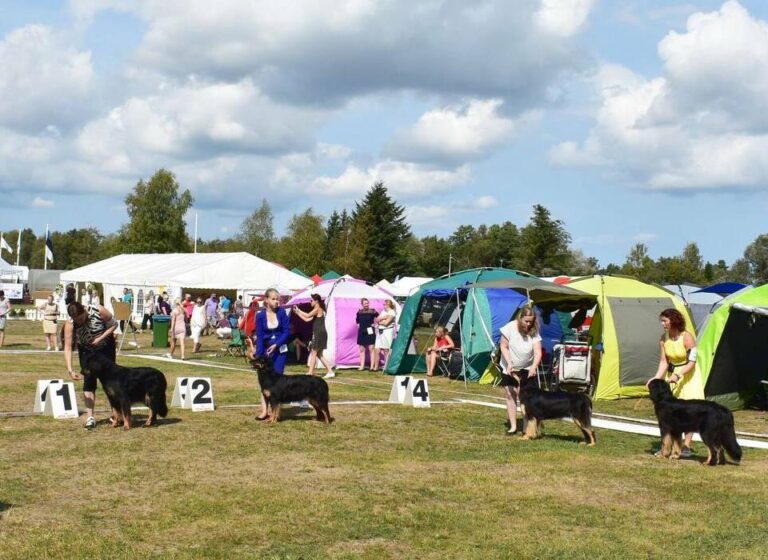The aim of a dog show is to find a purebred dog with the best conformity by general appearance (physique, movements, coat and temperament) to their respective breed standards.
If you wish to participate in a dog show (breed show/conformation show), either for travelling with your dog or for breeding intentions, participating in trainings will help you to prepare for show. In such trainings every element of a dog show is rehearsed. Additionally you can get answers from trainers for any questions you may happen to have, and suggestions on how and what to practice individually at home.
Your dog breeder can possibly provide you with different trainers’ contacts.
To introduce yourself and your dog to a dog show atmosphere, and to be prepared, choose some shows from the EKU calendar to visit as a spectator.
When enrolling to a dog show select proper class. You should submit your dog's exact age as what it will be on the date of the show when the dog show will be taking place.
Make sure your dog is up to date on required vaccines.
When departing to a dog show, take a water bottle, treats, and poop bags for your dog, also a dog show collar, participant number, veterinary Passport, and a good mood with you.
At dog show there is no point to nag with or start teaching your dog. Rehearsal should be done during trainings and at home, before the dog show, not during it.
If you decide to participate with a puppy, keep your trainings playful and short, so that your puppy doesn't feel repleted and/or bored.

What happens at the ring?
At a showground there is a marked square, where dogs will be moving together with a handler.
HANDLER – the person presenting the dog to the judge and handling the dog in the ring.
A JUDGE observes dogs from the center of the ring – from where is the best overview of the participants. The judge is assisted by the ring steward and the show secretary.
Spectators have to stay outside of the ring margins.

How dogs are evaluated?
The RING STEWARD invites participants one by one (according to their numbers) into the ring.
The JUDGE checks the dog's teeth, touches the dog from the chest to the tail-end, in the case of a male dog his testicles are also checked.
Then the JUDGE asks for gaiting to evaluate dog's dynamics. This usually consists of two movement stages: back and forth, and circular.
If there are several dogs in the ring (in the case of selecting the best of a breed), then the judge tells, how many circles have to be performed. Usually, dogs are gaited on the left side of their handler so the judge can always see the dog.
Description of a dog show
After gaiting, a handler stacks the dog in front of the judge (a side towards the judge) so that the anatomy of the dog was well exposed. The show secretary takes notes of judges remarks to the dog's description form. After receiving the filled form, a handler and their dog may leave the ring.
Calm standing during stacking leaves a better impression to judges and may affect the score. Practice stacking at home!
What next?
According to Judge’s decision, competition continues for dogs who have been awarded grades “Excellent” or “Very Good”.
The best male and female (bitch) are competing for the title THE BEST OF BREED.
Judges decide BOB and BOS (the best of breed, the best of opposite sex).
BOB will continue to compete in the Best of Group round and in the case of winning it, they’ll also compete in the Best in Show round.
Colors of grades:
- Excellent E - red ribbon
- Very good VG - blue ribbon
- Good G - yellow ribbon
- Adequate A - green ribbon
- Disqualified DSQ - gray ribbon
- Cannot be judged/excused - brown ribbon
Classes
Presetation and judging rounds proceed by classes, males and bitches separately, in increasing order of age. Males of a class are judged first, followed by the females (bitches).
– Minor Puppy Class (4-6 months) – optional, included at organizer's will
– Puppy Class (6-9 months)
– Junior Class (9-18 months)
– Intermediate Class (15-24 months)
– Open Class (from 15 months)
– Working Class (from 15 months)
– Champion Class (from 15 months)
– Veteran Class (from 8 years)
– Breeders Class
– Progeny Class
– Brace/Couple Class
Classes, that do not participate in competition for SERT, JUN-SERT, VET-SERT and CACIB awards:
– Minor Puppy Class (4-6 months) – optional, included at organizer's will
– Puppy Class (6-9 months)
Titles
Estonian Junior Champion (EST J CH);
Estonian Champion (EST CH);
Estonian Veteran Champion (EST Vet CH);
Baltic Junior Champion (BALT J CH);
Baltic Champion (BALT CH);
Baltic Veteran Champion (BALT Vet CH);
Estonian Lure Coursing Champion (EST M CH);
Estonian Agility Champion (EST AG CH);
Estonian Obedience Champion (EST IPO CH, EST PJK CH, EST SK CH, EST KK CH, EST FH CH, EST IPO-R CH, EST VP CH).
EST FH CH, EST IPO-R CH, EST VP CH).

What kind of dog shows there are?
- • NATIONAL DOG SHOW: a dog could be awarded with SERT, JUN CERT or VET CERT (certificates).
It is easier for a novice dog and for a dog owner to start with participating in a smaller national show - there are less participants and tumult. - • INTERNATIONAL DOG SHOW: a dog could be awarded with CACIB, CERT,
JUN CERT and VET CERT - GROUP SHOW: dogs from one or two breed groups are participating, it's also possible to win CERTIFICATES or JUNIOR CERTIFICATES.
- BREED SPECIALTY SHOW: a dog show of one or many EKU approved breeds. It's possible to win CERTIFICATES or JUNIOR CERTIFICATES.
Selection of Champion Titles
- The title “Estonian Junior Champion” (EST JCH) is awarded to the dog, who has achieved three
junior certificates (JUN CERT) from three different judges. - The title “Estonian Champion” (EST V CH) is awarded to the dog,
who has achieved three Estonian Champion candidate certificates (CERT) or two junior certificates (JUN CERT) and two CERT-s from different judges, or
who has been awarded EST J CH title plus one CERT.
At least one CERT has to be obtained in the age over 24 months.
Working dogs that by FCI are required to perform working trials (incl. hovawart), have to commit breed-specific
working trials:
– obedience OPEN II stage (OB OPEN II);
– Estonian obedience training 1. stage grade “very good” (KK 1);
– international protection trial 1. stage (IPO 1);
– Schutzhund protection trial 1 (SchH 1);
– tracking trial 1. stage (PJK 1. stage). - Title from a title show – in addition to CERT or CACIB, in some shows dogs can be awarded with special titles of the title show, for instance „Estonian Winner“ is a reputable title show that additionally to the honoured title, allows to qualify to the world-famous Crufts show in England
These titles are granted for a lifetime, and are inscribed onto the breed certificate, near the name of the dog. - Champion of another country - If a dog is already an Estonian Champion, then in several countries it is possible to obtain a champion title of that country just by winning a single certificate from a dog show of that country. Some countries expect successfully performed working trials as well – learn about local requirements before attending dog shows abroad.
- International Champion – Having four CACIBs from three different countries. Interval between the first and the last CACIB obtainment dates should be at least one year and one day.
- Multi Champion – Having champion titles from at least five different countries.

Match Show
An unofficial dog show where both purebred dogs and mongrels can participate.
Match shows are good for socializing and for practice for beginners. Even for these shows it is required to have up-to-date immunization for every attending dog.

